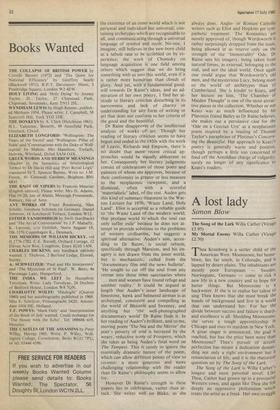Archetypal
Catherine Peters
Kathleen Raine's new book consists of 11 papers, all but one (an essay on the painter Charles Collins) given as lectures on various occasions during the past 14 years. There is a certain amount of repetition, in- evitable in such a collection, and the occa- sional inconsistency. In one paper Dr Raine suggests that western civilisation is wilfully destroying itself through its materialistic values; in another that we are living at the end of a cycle, and that the inevitable replacement of our society by another is on- ly one among many that the world has seen. But there is a remarkable consistency of at- tititude in these papers, which are mostly concerned with the creative process in poetry and painting. There is no discussion of music, the most abstract of arts, nor of the more humanly involved art of drama. Writing, for Dr. Raine, means poetry, almost without exception.
It is a neoplatonic view of life and art that Dr Raine puts forward as the basis for her discussions, the sophia perennis which she sees as underlying all true creativity. The perennial philosophy is not silly. It is not a cult, or an alternative religion. Aldous Hux- ley wrote of it that, 'in its fully developed forms it has a place in every one of the higher religions.' It postulates, in essence, the existence of an inner world which is not personal and individual but universal, con- taining archetypes which are recognisable to all, and communicating through a universal language of symbol and myth. No-one, I imagine, still believes in the new-born child as 'a tabula rasa to be scribbled on by ex- perience; the work of Chomsky on language acquisition is one field among others which suggest that we do bring something with us into this world, even if it is rather more humdrum than clouds of glory. And yet, with a fundamental good- will towards Dr Raine's ideas, and an ad- miration of her own poetry, I find her at- titude to literary criticism disturbing in its narrowness and lack of charity or understanding for any form of writing or art that does not conform to her criteria of the good and the beautiful.
Dr Raine disapproves of the intellectual analysis of works of art. Though her reading of literary criticism seems to have begun and ended in the 1920s with the work of Leavis, Richards and Empson, there is no doubt that more recent critical ap- proaches would be equally abhorrent to her. Consequently her literary judgments consist of celebrations of those poets and painters of whom she approves, because of their conformity in greater or less measure to the neoplatonic viewpoint, and a dismissal, often with a scornful 'materialistic' label, of the rest. Auden gets this kind of summary treatment in the War- ton Lecture for 1976, 'Waste Land, Holy Land'. Eliot is accepted as a reliable guide to 'the Waste Land of the modern world; that profane world in which the soul can only suffer exile' because he does not at- tempt to provide solutions to the problems of western civilisation, but suggests a spiritual alternative. Auden's aim, accor- ding to Dr Raine, is social reform, specifically through Marxism, and his im- agery is not drawn from the ,inner world, but is mechanistic, culled from the 'documentary film and the news bulletin'. 'He sought to cut off the soul from any retreat into those inner sanctuaries where ... men and women have found refuge and another reality.' It could be argued at length that Auden's inner landscape of limestone, hawk and helmeted airman is as archetypal, consistent and compelling as the world of Bleistein and Sweeney, and anything but 'the well-photographed documentary world' Dr Raine finds it. In her reading of Auden's brilliant, and to me, moving poem 'The Sea and the Mirror' the poet's poverty of soul is betrayed by the weary, reductive irony of Prospero, which she takes as being Auden's final word on The Tempest. This is surely to ignore the essentially dramatic nature of the poem, which can allow different points of view to co-exist: a more generous and more challenging relationship with the reader than Dr Raine's philosophy seems to allow for.
However Dr Raine's strength in these papers lies in celebration, rather than at- tack. She writes well on Blake, as she
always does. Anglo- or Roman Catholic writers such as Eliot and Hopkins get sym- pathetic treatment. The Romantics are mostly approved of, though Wordsworth 15 rather surprisingly dropped from the team, being allowed in as reserve only on the strength of the 'Immortality' Ode. Dr Raine sees his imagery, being taken from natural forms, as external, belonging to the real, and not the ideal world. Once again one could argue that Wordsworth's old men, and the mysterious Lucy, belong more to the world of archetypes than of Cumberland. She is kinder to Keats, and her lecture on him, 'The Chamber of Maiden Thought' is one of the most attrac- tive pieces in the collection. Whether or not Keats was as much influenced by his Platonist friend Bailey as Dr Raine believes, she makes out a persuasive case for the 'Ode on a Grecian Urn' as a neoplatonist poem inspired by a reading of Thomas Taylor's paraphrase of Plotinus's Concern- ing the Beautiful. Her approach to Keats's poetry is generally warm and positive, though perhaps a little too concerned to fend off the Arnoldian charge of vulgarity, surely no longer of any significance to Keats's readers.



































 Previous page
Previous page